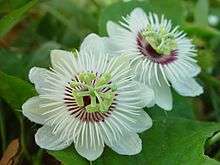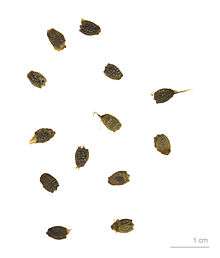Passiflora foetida
| Passiflora foetida | |
|---|---|
 | |
| Passiflora foetida flowers | |
 | |
| Passiflora foetida fruits | |
| Scientific classification | |
| Kingdom: | Plantae |
| (unranked): | Angiosperms |
| (unranked): | Eudicots |
| (unranked): | Rosids |
| Order: | Malpighiales |
| Family: | Passifloraceae |
| Genus: | Passiflora |
| Subgenus: | Passiflora |
| Species: | P. foetida |
| Binomial name | |
| Passiflora foetida L. | |
Passiflora foetida (common names: wild maracuja, bush passion fruit,[1] marya-marya, wild water lemon,[2] stinking passionflower,[2] love-in-a-mist or running pop[2]) is a species of passion flower that is native to the southwestern United States (southern Texas and Arizona), Mexico, the Caribbean, Central America, and much of South America. It has been introduced to tropical regions around the world,[2] such as Southeast Asia and Hawaii.[3] It is a creeping vine like other members of the genus, and yields an edible fruit.[4] The specific epithet, foetida, means "stinking" in Latin and refers to the strong aroma emitted by damaged foliage.[5]
Description


The stems are thin and wiry, covered with minute sticky yellow hairs. Older stems become woody. The leaves are three- to five-lobed and viscid-hairy. When crushed, these leaves give off a pungent odor that some people consider unpleasant. The flowers are white to pale cream coloured, about 5–6 cm diameter. The fruit is globose, 2–3 cm diameter, yellowish-orange to red when ripe, and has numerous black seeds embedded in the pulp; the fruit are eaten and the seeds dispersed by birds
P. foetida is able to trap insects on its bracts, which exude a sticky substance that also contains digestive enzymes. This minimizes predation on young flowers and fruits.[6] Whether or not it gains nourishment from its prey is uncertain, and it is currently considered a protocarnivorous plant.[7]
This passion flower tolerates arid ground, but favours moist areas. It is known to be an invasive species in some areas.[4] This plant is also a widely grown perennial climber, and has been used in traditional medicine.[8]
Uses
The fruits are roughly the size of a ping pong ball or kumquat and contain a bluish-white pulp that is mildly sweet and delicately flavored. In the Philippines, the fruit of Passiflora foetida are known colloquially as marya-marya ('Little Mary'), 'kurombot', and santo papa (due to its resemblance to the Pope's mitre). Young leaves and plant tips are also edible. Dry leaves are used in tea in Vietnamese folk medicine to relieve sleeping problems, as well as treatment for itching and coughs.[9]
Animal interactions
Passiflora foetida is a larval host and nectar source for the Gulf fritillary (Agraulis vanillae).[10]
Passiflora foetida has been mentioned as a toxic plant by farmers from northeastern Brazil. An experiment done with goats led to the discovery that high levels of cyanide in P. foetida cause poisoning after the ingestion of fresh leaves, mostly during the dry season.[11]
References
| Wikimedia Commons has media related to Passiflora foetida. |
- ↑ Alegre’s exotic culinary discoveries By Aissa dela Cruz
- 1 2 3 4 "Passiflora foetida L.". Germplasm Resources Information Network. United States Department of Agriculture. 2007-07-25. Retrieved 2010-01-06.
- ↑ Food Standards: Passiflora foetida
- 1 2 "Passiflora foetida (vine, climber)". Global Invasive Species Database. Invasive Species Specialist Group. 2006-03-23. Retrieved 2010-01-07.
- ↑ Nellis, David W. (1997). Poisonous Plants and Animals of Florida and the Caribbean. Pineapple Press Inc. p. 224. ISBN 978-1-56164-111-6.
- ↑ Radhamani, T R; L Sudarshana; Rani Krishnan (December 1995). "Defense and carnivory: Dual role of bracts in Passiflora foetida" (PDF). Journal of Biosciences. 20 (5): 657–664. doi:10.1007/BF02703305.
- ↑ "Carnivorous Plants / Insectivorous Plants". Botanical Society of America. Retrieved 2010-01-07.
- ↑ Sathish, R.; Sahu, Alok; Natarajan, K. (May–June 2011). "Antiulcer and antioxidant activity of ethanolic extract of Passiflora foetida L.". Indian Journal of Pharmacology. 43 (3): 336–339. doi:10.4103/0253-7613.81501. PMID 21713043.
- ↑ Tanaka, Yoshitaka; Van Ke, Nguyen (2007). Edible Wild Plants of Vietnam: The Bountiful Garden. Thailand: Orchid Press. p. 109. ISBN 9745240893.
- ↑ http://www.wildflower.org/plants/result.php?id_plant=PAFO2
- ↑ Carvalho, Fabricio K. de L.; de Medeiros, Rosane M. T.; de Araujo, Jose A. S.; Riet-Correa, Franklin (June 2011). "Experimental poisoning by Passiflora foetida (Passifloraceae) in goats". Pesquisa Veterinaria Brasileira. 31 (6): 477–481.
Further reading
Rosa, Yara Brito Chain Jardim; Dornelas, Marcelo Carnier (9 August 2011). "In vitro plant regeneration and de novo differentiation of secretory trichomes in Passiflora foetida L. (Passifloraceae)". Plant Cell, Tissue and Organ Culture (PCTOC). 108 (1): 91–99. doi:10.1007/s11240-011-0016-6.